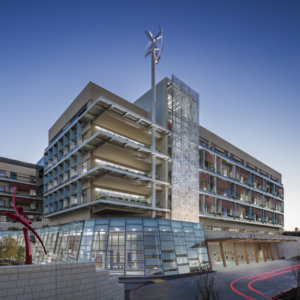Sustainability
Setting the bar for sustainable design


The new Main building at Lucile Packard Children’s Hospital Stanford has been awarded LEED Platinum certification by the U.S. Green Building Council (USGBC). Packard Children’s is one of just five new hospitals in the world — and the second children’s hospital —to earn the USGBC’s Platinum designation, the highest designation for sustainability awarded by the U.S. Green Building Council. Architect Perkins + Will in association with Hammel, Green and Abrahamson Architects, used innovative sustainability features as a driving force behind the design of our hospital, including water-conservation features, renewable energy use, recycling programs and landscape concept conservation, to green housekeeping and local food offerings
Our hospital is designed to use 38 percent less water and 60 percent less energy than the average Northern California hospital. We created permeable surfaces to absorb storm drainage, and will irrigate our native landscaping with rainwater and condensate water that is extracted from dehumidifying indoor air. All of this water will be collected in two 55,000-gallon underground cisterns.
Harnessing next-generation architectural design, the building was oriented to take into account the sun’s movement which allows for optimal air flow and energy performance. This decreases the need for air conditioning which consumes energy and water.
How much energy are we saving on a given day? You can find out in our lobby and through the in-room TV system where a child-friendly electronic dashboard displays the building’s ongoing water and energy usage.
We are using recycled and reclaimed items wherever possible, including enclosing our main elevator bank in wood from the Moffett Field Hangar so that it resembles a giant redwood tree.
“The elevator tower looks and feels like being inside a redwood tree. Early on we explored the idea of mimicking a redwood tree trunk with the elevator core. We wanted it to feel like a real tree that kids could touch and hug. We wanted the experience to be grand and very tactile.”
The building’s ongoing water and energy usage will be displayed on an electronic dashboard in the main lobby and on bedside entertainment systems, allowing children to compare energy consumption in different areas of the hospital.

